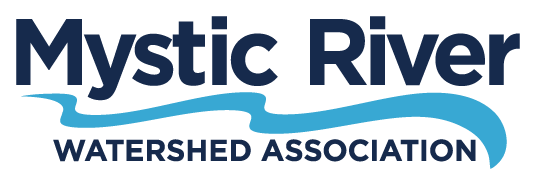By John Kilborn, Winchester resident, with help from John Shawcross, Ann Storer, and Beth MacBlane
The Mystic River watershed, including the Aberjona River in Winchester, supports one of the largest upstream runs, or migrations, of river herring in Massachusetts. Efforts are underway to build a fish ladder in Winchester, which could increase the number of migrating herring, perhaps making the migration the largest in the Commonwealth.
Each spring, schools of river herring swim up the Mystic River from the Atlantic to spawn (lay eggs) in the fresh waters of the watershed. The adults quickly return to the ocean after spawning, but the juvenile fish grow and migrate back to the ocean in late summer and fall. Most herring spawn in the same river system where they were hatched.
These small but numerous fish are an important part of the ecosystem. They provide food for marine mammals like whales; land animals; fish, such as striped bass; and local birds, such as, herons and eagles.
Historical records discovered by the Town Archivist from the 1870s confirm that there was an active herring run into Winchester, and “great numbers” of herring were taken for food and other purposes. In 1870, Winchester built a fishway over the Central Falls dam in Winchester center at Main Street. In 1872, it was reported that the herring “swarmed in our waters last spring.”
But by the early 1900s, the herring migration was likely blocked by dams and other man-made obstructions, and water quality was poor. In 2011, however, the state constructed a fish ladder in the Mystic Lakes dam that allows the herring to bypass the dam and swim farther upstream. This ladder has opened up significant new habitat suitable for herring reproduction. In 2015, the number of fish using the ladder almost doubled, perhaps as a result of the additional habitat.
Winchester's Central Falls Dam. © David Mussina.
The fish are now blocked by Winchester’s Central Falls dam. (This is this semi-circular dam next to Lincoln School and across from the Library.) Last June, thousands of fish were stuck in front of the dam, and observers said that it looked as if you could cross the river on the backs of the herring. When the dam’s floodgates were opened, the fish quickly swam up river—all the way to Horn Pond in Woburn, which could provide significant new breeding habitat.
Local volunteers, Town of Winchester officials, and the Mystic River Watershed Association (MyRWA) have been working to install a fish ladder in Winchester’s Central Falls dam. This ladder will allow the herring to pass up and down river, while allowing the Town to control the water levels of the Mill Pond by the library.
With funding from the En Ka Society, MyRWA tested the quality of the Aberjona for two years to ensure that it was good enough for spawning and fish growth. Although the Aberjona has some water quality impairments, none are significant enough to stop the migration.
The good news is that construction of a fish ladder at Winchester’s Central Falls dam may begin this November. Agreements for the construction are not yet complete, but a final design is being prepared. The performing parties at a Superfund cleanup site in Woburn have preliminarily agreed to fund construction of the ladder. In addition, the state will make improvements to a spillway in Horn Pond to ease fish passage into Horn Pond. If the fish can get up to Horn Pond, the Mystic River watershed has the potential to support the largest run of herring in Massachusetts.
This community effort to construct these fish ladders is a critical step in restoring the Aberjona and larger watershed. The fish ladders will open new herring habitat that will help increase the herring population. That, in turn, will support many other kinds of wildlife. Winchester has a unique opportunity to restore the herring migration to its past glory. The Aberjona can again become a living river, and we can all see the herring in their “great numbers.”






